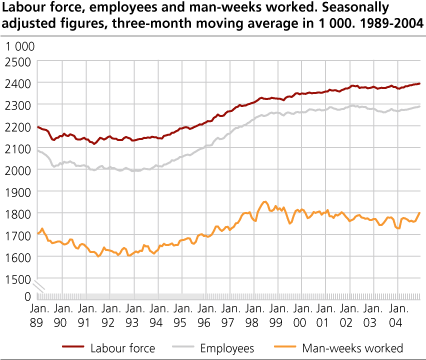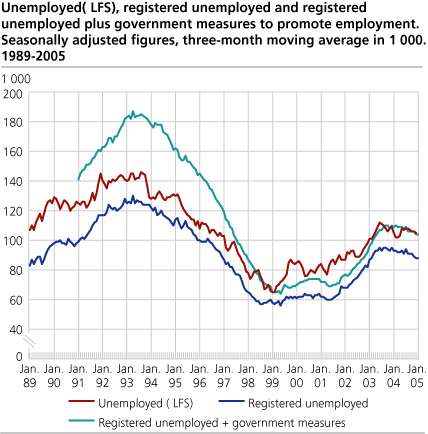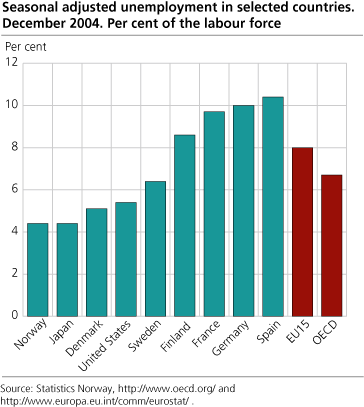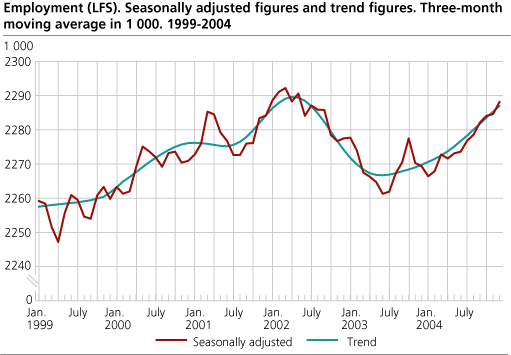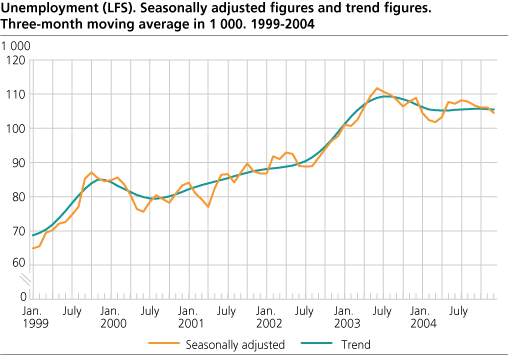Content
Published:
This is an archived release.
Employment still rising
The number of employees continued to rise in December and moved towards the record level from the spring of 2002. Unemployment remained on a stable level, but has declined somewhat from the previous year. The figures presented in this article are adjusted for seasonal variations.
Following a period of decline from the spring of 2002, employment started to increase in the summer of 2003. From September (the August-October period) to December 2004 (November-January), the number of employees rose by 6 000, which is inside the error margin of the Labour Force Survey (LFS). Employment still appears to be in an upward trend, and is almost as high as the record level measured in the spring of 2002.
The figure for December 2004 shows a decline in unemployment by 2 000 from September. However, this is clearly inside the LFS error margin. Seasonally adjusted figures of registered unemployment at job centres plus government measures to promote employment fell correspondingly from September to December.
Lower unemployment in Nordic countries
The seasonally adjusted unemployment rate for Norway was 4.4 per cent in December 2004, compared with 4.5 per cent in September. In the same period, unemployment in the EU and OECD area stayed approximately unchanged at 8.0 and 6.7 per cent respectively. The figure stayed unchanged in the USA too, at 5.4 per cent. From September to December the unemployment rate fell from 6.6 to 6.4 per cent in Sweden, from 5.3 to 5.1 per cent in Denmark, and from 8.8 to 8.6 per cent in Finland. In France and Germany unemployment stayed approximately unchanged at 9.7 and 10.0 per cent respectively, according to figures from the OECD and Eurostat .
Man-weeks worked showed a downward trend between June 1998 and May 2003. Since then, the figures have been relatively stable. From September to December 2004, man-weeks worked went up by 41 000, which is clearly outside the LFS error margin. However, all or some of the increase is attributable to the small number of days off in connection with the Christmas holidays in 2004.
Uncertain figures
Quality tests show that the seasonally adjusted LFS unemployment figures are uncertain. The seasonal-adjustment method has problems identifying a stable seasonal pattern for this series. The random component is relatively large compared with the seasonal component. The figures should therefore be treated with caution.
The purpose of adjusting for seasonal variations is to describe the development over the last year and provide figures of change between the last two three-month periods, corrected for normal seasonal variations. In order to reduce uncertainty, the published series are three-month moving averages of the seasonally adjusted figures. For instance, the figures for December represent the average of the estimates for November, December and January.
Tables:
The statistics is published with Labour force survey.
Contact
-
Arbeidsmarked og lønn
E-mail: arbeidsmarked@ssb.no
-
Erik Herstad Horgen
E-mail: erik.horgen@ssb.no
tel.: (+47) 93 08 68 62

